Shop by Vehicle for Tire Pressure Monitoring System (TPMS) Sensors
Have you ever seen a vehicle with one or more tires that appear noticeably low on tire pressure? Didn't you want to warn the driver of the situation before that slight inconvenience became a calamity? What if the vehicle with the low tire pressures is the one you're driving? Wouldn't you want to be warned?
The United States Department of Transportation (DOT) National Highway Traffic Safety Administration (NHTSA) has developed a Federal Motor Vehicle Safety Standard that requires the installation of tire pressure monitoring systems (TPMS) that warn the driver when a tire is significantly under-inflated. The standard applies to passenger cars, trucks, multi-purpose passenger vehicles and buses with a gross vehicle weight rating of 10,000 pounds or less, except those vehicles with dual wheels on an axle.
Maintaining the correct tire pressure for a vehicle is an important factor in how much load its tires can safely carry. The correct pressure will carry the weight without a problem. Too little tire pressure will eventually cause catastrophic tire failure.
Tires aren't invincible. They are made of individual layers of fabric and steel encased in rubber. If a tire is allowed to run low on air pressure, the rubber is forced to stretch beyond the elastic limits of the fabric and steel reinforcing cords. When this happens, the bond between the various materials can weaken. If this is allowed to continue, it will eventually break the bonds between the various materials and cause the tire to fail. And even if the tire doesn't fail immediately, once a tire is weakened it won't heal after being re-inflated to the proper pressure. So if a tire has been allowed to run nearly flat for a period of time, the tire should be replaced, not simply repaired or re-inflated.
Studies have shown that running tires with too little air pressure is not uncommon. It's been estimated that about one out of every four vehicles on the road is running on under-inflated tires. This also means that one out of every four drivers is needlessly sacrificing their vehicle's fuel economy and handling, and reducing their tires' durability and tread life.
This has made tire pressure maintenance an important safety issue throughout the automotive industry and caused the U.S. government to pass legislation mandating tire pressure monitoring systems. The main purpose of these systems is to warn the driver if their tires are losing air pressure, leaving the tires under-inflated and dangerous.
What types of systems are being used now? How do they work? Which works the best?
The National Highway Traffic Safety Administration (NHTSA) provides vehicle manufacturers options with which they can comply with the law. One option is to install a direct tire pressure monitoring system that uses pressure sensors located in each wheel to directly measure the pressure in each tire and warns drivers when the air pressure in any of their tires drops at least 25% below the recommended cold tire inflation pressure identified on the vehicle placard. Another option is to install an indirect tire pressure monitoring system that would warn the driver when a single tire has lost at least 25% of its inflation pressure compared to other tires on the vehicle. While direct systems could offer more precise warning thresholds, indirect systems cannot offer the same information or accuracy.
| What's the Difference? |
| DIRECT VS INDIRECT |
Direct
attach a pressure sensor/transmitter to the vehicle's wheels. An in-vehicle receiver warns the driver if the pressure in any tire falls below a predetermined level. Direct systems are typically more accurate and reliable and most are able to indicate which tire is under-inflated. |
Indirect
use the vehicle's anti-lock braking system's wheel speed sensors to compare the rotational speed of one tire versus the others. If a tire is low on pressure, it will roll at a different number of revolutions per mile than the other three and alert the vehicle's on-board computer. Indirect systems (except for the TPMS on several 2009+ Audi models and 2010+ Volkswagen models) are unable to generate accurate readings in cases where all four tires are losing pressure at the same rate, such as the effects of time and temperature. |
Direct Monitoring Systems
Direct tire pressure monitoring systems measure, identify and warn the driver of low pressure. Because direct systems have a sensor in each wheel, they generate accurate warnings and can alert the driver instantly if the pressure in any one tire falls below a predetermined level due to rapid air loss caused by a puncture. In addition, direct tire pressure monitoring systems can detect gradual air loss over time. Some direct systems use dashboard displays that provide the ability to check current tire pressures from the driver's seat.
Direct systems attach a pressure sensor/transmitter to the vehicle's wheel inside the tire's air chamber. Most Original Equipment and some aftermarket systems attach their air pressure sensor/transmitter to special tire valves. While the presence of a metal clamp-in valve typically identifies the presence of a direct tire pressure monitoring system, special snap-in rubber valves have also been used to support direct system sensors. The transmitter's signal is broadcast to the in-car receiver and the information is displayed to the driver.
Some aftermarket and Original Equipment direct monitoring systems attach the sensor/transmitter to the wheel with an adjustable metal strap. These sensors/transmitters and their straps only weigh a few ounces and allow virtually universal application on car and light truck wheels. Since standard snap-in rubber valves are still used for these applications, it is important that the owners of these systems let their tire installer know that the vehicle is equipped with a direct system banded to the wheel before they change the tires.
Tire Rack works with wheel manufacturers to develop aftermarket wheels that accommodate direct tire pressure monitoring sensors/transmitters. This results in our ability to offer a wider selection of aftermarket alloy wheel styles that accept Original Equipment direct system components. Additionally, the Tire Rack's fitment specialists have carefully determined which aftermarket wheels will be compatible with the vehicle and system installed for customers purchasing Tire & Wheel Packages or wheel upgrades. Search results include notes regarding TPMS sensors and sensors can confidently be purchased online with wheels.
"...tire pressure maintenance [is] an important safety issue throughout the automotive industry and caused the U.S. government to pass legislation mandating tire pressure monitoring systems. "
ShowHide TPMS sensors currently being offered as standard or optional equipment on select U.S. vehicles.
Beru

Audi, Bentley, BMW, Bugatti, Ferrari, Hyundai, Kia, Lamborghini, Land Rover, Maserati, Maybach, Mercedes-Benz, Mini, Porsche, Rolls Royce, Volkswagen
Lear
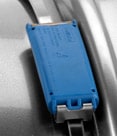
Ford, Lincoln, Mazda, Mercury, Roush, Saleen
Pacific
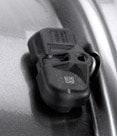
Acura, Honda, Infiniti, Lexus, Pontiac, Scion, Toyota
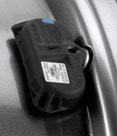
Lexus
Schrader
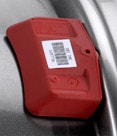
Chevrolet, Chrysler, Plymouth
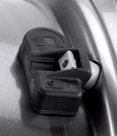
Chrysler, Dodge, Jeep, Mercedes-Benz, SMART
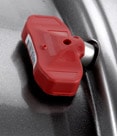
Buick, Cadillac, Chevrolet, GMC, Hummer, Isuzu, Saab
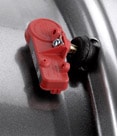
Buick, Cadillac, Chevrolet, Ford, GMC, Hummer, Pontiac, Saturn, Subaru, Suzuki
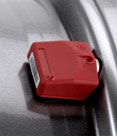
Cadillac, Chevrolet, Chrysler, Dodge, Ford, Infiniti, Jeep, Lincoln, Lotus, Mercury, Mitsubishi, Nissan, Saab, Saturn, Subaru, Suzuki, Volvo
Siemens

Audi, Buick, Chevrolet, Chrysler, Dodge, GMC, Jaguar, Jeep, Land Rover, Mazda, Mitsubishi, Pontiac, Saturn, Suzuki, Volkswagen, Volvo
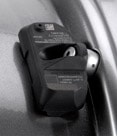
Dodge, Mercedes-Benz
SmarTire
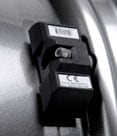
Aston Martin
TRW
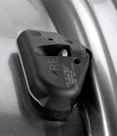
Acura, Honda, Hyundai, Kia
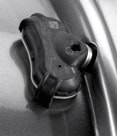
Acura, Honda, Hyundai, Kia, Toyota
Indirect Monitoring Systems
In the interest of providing a lower cost Original Equipment system, indirect tire pressure monitoring systems were developed by vehicle manufacturers wishing to comply with the law while minimizing development time and cost. Indirect systems use the vehicle's anti-lock braking system's wheel speed sensors to compare the rotational speed of one tire to that in another position on the vehicle. If one tire is low on pressure, its circumference changes enough to roll at a slightly different number of revolutions per mile than the other three tires. Reading the same signal used to support ABS systems, the vehicle manufacturers have programmed another function into the vehicle's on-board computer to warn the driver when a single tire is running at a reduced inflation pressure compared to the others.
Unfortunately, indirect tire pressure monitoring systems have several shortcomings. Indirect systems won't tell the drivers which tire is low on pressure, and won't warn the driver if all four tires are losing pressure at the same rate (as occurs during the fall and winter months when ambient temperatures get colder). Additionally, our current experience with indirect systems indicates that they can generate frequent false warnings. We have found that false warnings may occur when the tires spin on wet, icy and snow-covered roads. In these cases, the false alarms would train the driver to disregard the tire pressure monitoring system's warnings, negating its purpose completely.
Concerns
While the Tire Rack applauds the emphasis on maintaining appropriate tire pressure and requiring a system that will warn the driver if low pressure is detected, we are concerned about the percentage of under-inflation that the law permits before warning the driver. The driver of a passenger car that calls for 35 psi may not be warned about tire pressure loss until it drops to 26 psi depending on the type of monitoring system used. Under the same circumstances, a driver of a light truck that calls for 80 psi won't be warned until just 60 psi remains. In both of these cases, significant load capacity has been sacrificed before the driver is warned.
The only way to overcome this obstacle would be to fit significantly over-sized tires to every new vehicle that could compensate for a 25% loss in tire pressure before becoming overloaded. Unfortunately, these larger tires would add to gross vehicle weight, generate more rolling resistance and increase the vehicle's aerodynamic drag. This would result in a loss of fuel economy and increased gasoline consumption in direct contrast to the government's Corporate Average Fuel Economy (CAFE) requirements for cars and light trucks.
While the legislation is well intended, we feel that direct tire pressure monitoring systems are the better means to warn the driver of low tire pressure before inconvenience becomes calamity. Additionally, we are concerned that the drivers of vehicles equipped with any tire pressure monitoring system will become over confident in the capabilities of their system and will be even less likely to confirm their vehicle's cold tire pressure with a pressure gauge at least once a month and before long trips.
Shop by Vehicle for Tire Pressure Monitoring System (TPMS) Sensors
Was this post helpful?
485 of 787 people found this post helpful















